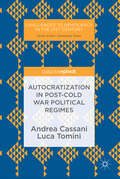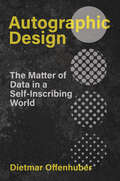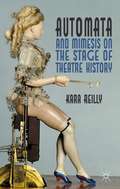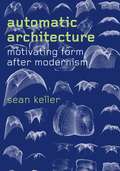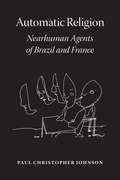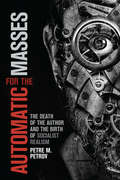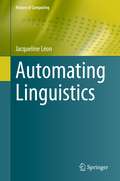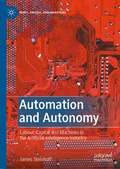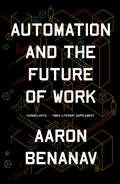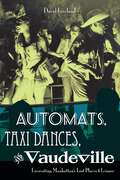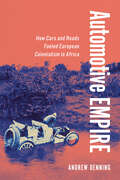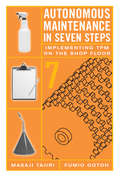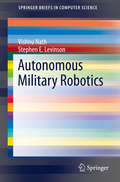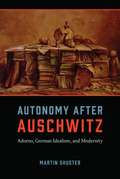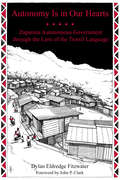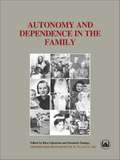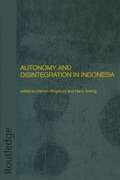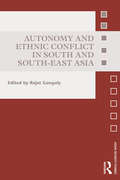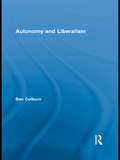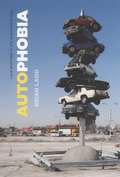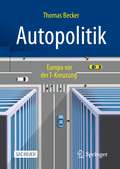- Table View
- List View
Autocratization in post-Cold War Political Regimes (Challenges to Democracy in the 21st Century)
by Luca Tomini Andrea CassaniThis book deals with post-Cold War processes of autocratization, that is, regime change towards autocracy. While these processes are growing in number and frequency, autocratization remains a relatively understudied phenomenon, especially its most recent manifestations. In this volume, the authors offer one of the first cross-regional comparative analyses of the recent processes of regime change towards autocracy. Building on an original conceptual framework, the two authors engage in the empirical investigation of the spreading of this political syndrome, of the main forms that it takes, and of the modes through which it unfolds in countries ruled by different political regimes, with different histories and belonging to different regional contexts. The research is conducted through a mix of research techniques that include descriptive statistical analysis, Qualitative Comparative Analysis and case study. This book will be of interest to a heterogeneous readership that encompasses the broader community of scholars, analysts, observers, journalists, and practitioners interested in political development and regime change in different geographical areas.
Autographic Design: The Matter of Data in a Self-Inscribing World (metaLAB Projects)
by Dietmar OffenhuberAn ambitious vision for design based on the premise that data is material, not abstract.Data analysis and visualization are crucial tools in today's society, and digital representations have steadily become the default. Yet, more and more often, we find that citizen scientists, environmental activists, and forensic amateurs are using analog methods to present evidence of pollution, climate change, and the spread of disinformation. In this illuminating book, Dietmar Offenhuber presents a model for these practices, a model to make data generation accountable: autographic design.Autographic refers to the notion that every event inscribes itself in countless ways. Think of a sundial, for example—a perfectly autographic device that displays information on itself. Inspired by such post-digital practices of visualization and evidence construction, Offenhuber describes an approach to visualization based on the premise that data is a material entity rather than an abstract representation. Emerson wrote, &“Every act of the man inscribes itself in the memories of his fellows, and in his own manners and face.&” In Autographic Design, Offenhuber introduces a model for design that emphasizes traces, imprints, and self-inscriptions, turning them into sensory displays.In an age where misinformation is harder and harder to identify, Autographic Design makes an urgent and persuasive case for a different approach that calls attention to the production of data and its connection to the material world.
Automata and Mimesis on the Stage of Theatre History
by Kara ReillyThe automaton, known today as the robot, can be seen as a metaphor for the historical period in which it is explored. Chapters include examinations of Iconoclasm's fear that art might surpass nature, the Cartesian mind/body divide, automata as objects of courtly desire, the uncanny Olympia, and the revolutionary Robots in post-WWI drama.
Automatic Architecture: Motivating Form after Modernism
by Sean KellerIn the 1960s and ’70s, architects, influenced by recent developments in computing and the rise of structuralist and poststructuralist thinking, began to radically rethink how architecture could be created. Though various new approaches gained favor, they had one thing in common: they advocated moving away from the traditional reliance on an individual architect’s knowledge and instincts and toward the use of external tools and processes that were considered objective, logical, or natural. Automatic architecture was born. The quixotic attempts to formulate such design processes extended modernist principles and tried to draw architecture closer to mathematics and the sciences. By focusing on design methods, and by examining evidence at a range of scales—from institutions to individual buildings—Automatic Architecture offers an alternative to narratives of this period that have presented postmodernism as a question of style, as the methods and techniques traced here have been more deeply consequential than the many stylistic shifts of the past half century. Sean Keller closes the book with an analysis of the contemporary condition, suggesting future paths for architectural practice that work through, but also beyond, the merely automatic.
Automatic Religion: Nearhuman Agents of Brazil and France
by Paul Christopher JohnsonWhat distinguishes humans from nonhumans? Two common answers—free will and religion—are in some ways fundamentally opposed. Whereas free will enjoys a central place in our ideas of spontaneity, authorship, and deliberation, religious practices seem to involve a suspension of or relief from the exercise of our will. What, then, is agency, and why has it occupied such a central place in theories of the human?Automatic Religion explores an unlikely series of episodes from the end of the nineteenth century, when crucial ideas related to automatism and, in a different realm, the study of religion were both being born. Paul Christopher Johnson draws on years of archival and ethnographic research in Brazil and France to explore the crucial boundaries being drawn at the time between humans, “nearhumans,” and automata. As agency came to take on a more central place in the philosophical, moral, and legal traditions of the West, certain classes of people were excluded as less-than-human. Tracking the circulation of ideas across the Atlantic, Johnson tests those boundaries, revealing how they were constructed on largely gendered and racial foundations. In the process, he reanimates one of the most mysterious and yet foundational questions in trans-Atlantic thought: what is agency?
Automatic for the Masses
by Petre M. PetrovAt the end of the 1920s, the Modernist and avant-garde artistic programmes of the early Soviet Union were swept away by the rise of Stalinism and the dictates of Socialist Realism. Did this aesthetic transition also constitute a conceptual break, or were there unseen continuities between these two movements? In Automatic for the Masses, Petre M. Petrov offers a novel, theoretically informed account of that transition, tracing those connections through Modernist notions of agency and authorship.Reading the statements and manifestos of the Formalists, Constructivists, and other Soviet avant-garde artists, Petrov argues that Socialist Realism perpetuated in a new form the Modernist "death of the author." In interpreting this symbolic demise, he shows how the official culture of the 1930s can be seen as a perverted realization of modernism's unrealizable project. An insightful and challenging interpretation of the era, Automatic for the Masses will be required reading for those interested in understanding early Soviet culture.
Automating Linguistics (History of Computing)
by Jacqueline LéonAutomating Linguistics offers an in-depth study of the history of the mathematisation and automation of the sciences of language. In the wake of the first mathematisation of the 1930s, two waves followed: machine translation in the 1950s and the development of computational linguistics and natural language processing in the 1960s. These waves were pivotal given the work of large computerised corpora in the 1990s and the unprecedented technological development of computers and software.Early machine translation was devised as a war technology originating in the sciences of war, amidst the amalgamate of mathematics, physics, logics, neurosciences, acoustics, and emerging sciences such as cybernetics and information theory. Machine translation was intended to provide mass translations for strategic purposes during the Cold War. Linguistics, in turn, did not belong to the sciences of war, and played a minor role in the pioneering projects of machine translation.Comparing the two trends, the present book reveals how the sciences of language gradually integrated the technologies of computing and software, resulting in the second-wave mathematisation of the study of language, which may be called mathematisation-automation. The integration took on various shapes contingent upon cultural and linguistic traditions (USA, ex-USSR, Great Britain and France). By contrast, working with large corpora in the 1990s, though enabled by unprecedented development of computing and software, was primarily a continuation of traditional approaches in the sciences of language sciences, such as the study of spoken and written texts, lexicography, and statistical studies of vocabulary.
Automation and Autonomy: Labour, Capital and Machines in the Artificial Intelligence Industry (Marx, Engels, and Marxisms)
by James SteinhoffThis book argues that Marxist theory is essential for understanding the contemporary industrialization of the form of artificial intelligence (AI) called machine learning. It includes a political economic history of AI, tracking how it went from a fringe research interest for a handful of scientists in the 1950s to a centerpiece of cybernetic capital fifty years later. It also includes a political economic study of the scale, scope and dynamics of the contemporary AI industry as well as a labour process analysis of commercial machine learning software production, based on interviews with workers and management in AI companies around the world, ranging from tiny startups to giant technology firms. On the basis of this study, Steinhoff develops a Marxist analysis to argue that the popular theory of immaterial labour, which holds that information technologies increase the autonomy of workers from capital, tending towards a post-capitalist economy, does not adequately describe the situation of high-tech digital labour today. In the AI industry, digital labour remains firmly under the control of capital. Steinhoff argues that theories discerning therein an emergent autonomy of labour are in fact witnessing labour’s increasing automation.
Automation and Human Solidarity
by Bill JordanThis book provides a detailed analysis of the economic and political implications of the introduction of Artificial Intelligence and Robotics into the service sector of economies that have so far relied on service jobs to sustain levels of employment. It examines how reliance on coercive measures for enforcing low-paid service work attempts to postpone this third Industrial Revolution, and analyses the struggles that must still take place if we are to achieve a future of freedom and social justice for all. While automation and globalisation have made human solidarities of traditional kinds more difficult to sustain, they have also made new kinds possible. Experiments in social policy, and especially the pilot projects with unconditional Universal Basic Incomes, offer a possible model for a new kind of society. The author argues that it is politics which will determine whether we can achieve these new human solidarities.
Automation and the Future of Work
by Aaron BenanavA consensus-shattering account of automation technologies and their effect on workplaces and the labor marketSilicon Valley titans, politicians, techno-futurists and social critics have united in arguing that we are living on the cusp of an era of rapid technological automation, heralding the end of work as we know it. But does the much-discussed &“rise of the robots&” really explain the jobs crisis that awaits us on the other side of the coronavirus? In Automation and the Future of Work, Aaron Benanav uncovers the structural economic trends that will shape our working lives far into the future. What social movements, he asks, are required to propel us into post-scarcity, if technological innovation alone can&’t deliver it? In response to calls for a universal basic income that would maintain a growing army of redundant workers, he offers a counter-proposal.
Automats, Taxi Dances, and Vaudeville: Excavating Manhattan’s Lost Places of Leisure
by David FreelandWinner of the Publication Award for Popular Culture and Entertainment for 2009 from the Metropolitan Chapter of the Victorian Society in AmericaNamed to Pop Matters list of the Best Books of 2009 (Non-fiction)From the lights that never go out on Broadway to its 24-hour subway system, New York City isn't called "the city that never sleeps" for nothing. Both native New Yorkers and tourists have played hard in Gotham for centuries, lindy hopping in 1930s Harlem, voguing in 1980s Chelsea, and refueling at all-night diners and bars. The slim island at the mouth of the Hudson River is packed with places of leisure and entertainment, but Manhattan's infamously fast pace of change means that many of these beautifully constructed and incredibly ornate buildings have disappeared, and with them a rich and ribald history.Yet with David Freeland as a guide, it's possible to uncover skeletons of New York's lost monuments to its nightlife. With a keen eye for architectural detail, Freeland opens doors, climbs onto rooftops, and gazes down alleyways to reveal several of the remaining hidden gems of Manhattan's nineteenth- and twentieth-century entertainment industry. From the Atlantic Garden German beer hall in present-day Chinatown to the city's first motion picture studio—Union Square's American Mutoscope and Biograph Company—to the Lincoln Theater in Harlem, Freeland situates each building within its historical and social context, bringing to life an old New York that took its diversions seriously. Freeland reminds us that the buildings that serve as architectural guideposts to yesteryear's recreations cannot be re-created—once destroyed they are gone forever. With condominiums and big box stores spreading over city blocks like wildfires, more and more of the Big Apple's legendary houses of mirth are being lost. By excavating the city's cultural history, this delightful book unearths some of the many mysteries that lurk around the corner and lets readers see the city in a whole new light.
Automotive Empire: How Cars and Roads Fueled European Colonialism in Africa
by Andrew DenningIn Automotive Empire, Andrew Denning uncovers how roads and vehicles began to transform colonial societies across Africa but rarely in the manner Europeans expected. Like seafaring ships and railroads, automobiles and roads were more than a mode of transport—they organized colonial spaces and structured the political, economic, and social relations of empire, both within African colonies and between colonies and the European metropole. European officials in French, Italian, British, German, Belgian, and Portuguese territories in Africa shared a common challenge—the transport problem. While they imagined that roads would radiate commerce and political hegemony by collapsing space, the pressures of constructing and maintaining roads rendered colonial administration thin, ineffective, and capricious. Automotive empire emerged as the European solution to the transport problem, but revealed weakness as much as it extended power. As Automotive Empire reveals, motor vehicles and roads seemed the ideal solution to the colonial transport problem. They were cheaper and quicker to construct than railroads, overcame the environmental limitations of rivers, and did not depend on the recruitment and supervision of African porters. At this pivotal moment of African colonialism, when European powers transitioned from claiming territories to administering and exploiting them, automotive empire defined colonial states and societies, along with the brutal and capricious nature of European colonialism itself.
Autonomous Maintenance in Seven Steps: Implementing TPM on the Shop Floor
by Fumio GotohAutonomous maintenance is an especially important pillar of Total Productive Maintenance (TPM) because it enlists the intelligence and skills of the people who are most familiar with factory machines-- equipment operators. Operators learn the maintenance skills they need to know through a seven-step autonomous maintenance program. Most companies in the West stop after implementing the first few steps and never realize the full benefits of autonomous maintenance. This book contains comprehensive coverage of all seven steps--not just the first three or four.It includes:An overview of autonomous maintenance features and checklists for step audits to certify team achievement at each AM step.TPM basics such as the six big losses, overall equipment effectiveness (OEE), causes of losses, and six major TPM activities.An implementation plan for TPM and five countermeasures for achieving zero breakdowns.Useful guidelines and case studies in applying AM to manual work such as assembly, inspection, and material handling.Integrates examples from Toyota, Asai Glass, Bridgestone, Hitachi, and other top companies.By treating machines as partners and taking responsibility for them, you get machines that you can rely on and help maintain an energized and responsive workplace. For companies that are serious about taking autonomous maintenance beyond mere cleaning programs, this is an essential sourcebook and implementation support.
Autonomous Military Robotics (SpringerBriefs in Computer Science)
by Vishnu Nath Stephen E. LevinsonThis SpringerBrief reveals the latest techniques in computer vision and machine learning on robots that are designed as accurate and efficient military snipers. Militaries around the world are investigating this technology to simplify the time, cost and safety measures necessary for training human snipers. These robots are developed by combining crucial aspects of computer science research areas including image processing, robotic kinematics and learning algorithms. The authors explain how a new humanoid robot, the iCub, uses high-speed cameras and computer vision algorithms to track the object that has been classified as a target. The robot adjusts its arm and the gun muzzle for maximum accuracy, due to a neural model that includes the parameters of its joint angles, the velocity of the bullet and the approximate distance of the target. A thorough literature review provides helpful context for the experiments. Of practical interest to military forces around the world, this brief is designed for professionals and researchers working in military robotics. It will also be useful for advanced level computer science students focused on computer vision, AI and machine learning issues.
Autonomous Motherhood?
by Susan B. Boyd Fiona Kelly Dorothy E. Chunn Wanda WiegersSince the end of the Second World War, increasing numbers of women have decided to become mothers without intending the biological father or a partner to participate in parenting. Many conceive via donor insemination or adopt; others become pregnant after a brief sexual relationship and decide to parent alone.Using a feminist socio-legal framework, Autonomous Motherhood? probes fundamental assumptions within the law about the nature of family and parenting. Drawing on a range of empirical evidence, including legislative history, case studies, and interviews with single mothers, the authors conclude that while women may now have the economic and social freedom to parent alone, they must still negotiate a socio-legal framework that suggests their choice goes against the interests of society, fatherhood, and children.
Autonomous State
by Dimitry AnastakisAutonomous State provides the first detailed examination of the Canadian auto industry, the country's most important economic sector, in the post-war period. In this engrossing book, Dimitry Anastakis chronicles the industry's evolution from the 1973 OPEC embargo to the 1989 Canada-US Free Trade Agreement and looks at its effects on public policy, diplomacy, business enterprise, workers, consumers, and firms.Using an immense array of archival sources, and interviews with some of the key actors in the events, Anastakis examines a fascinating array of topics in recent auto industry and Canadian business and economic history: the impact of new safety, emissions, and fuel economy regulations on the Canadian sector and consumers, the first Chrysler bailout of 1980, the curious life and death of the 1965 Canada-US auto pact, the 'invasion' of Japanese imports and transplant operations, and the end of aggressive auto policy-making with the coming of free trade.More than just an examination of the auto industry, the book provides a rethinking of Canada's tumultuous post-OPEC political and economic evolution, helping to explain the current tribulations of the global auto sector and Canada's place within it.
Autonomous Weapons Systems
by Liu Claus Kreß Susanne Beck Robin Geiß Nehal Bhuta Hin-YanThe intense and polemical debate over the legality and morality of weapons systems to which human cognitive functions are delegated (up to and including the capacity to select targets and release weapons without further human intervention) addresses a phenomena which does not yet exist but which is widely claimed to be emergent. This groundbreaking collection combines contributions from roboticists, legal scholars, philosophers and sociologists of science in order to recast the debate in a manner that clarifies key areas and articulates questions for future research. The contributors develop insights with direct policy relevance, including who bears responsibility for autonomous weapons systems, whether they would violate fundamental ethical and legal norms, and how to regulate their development. It is essential reading for those concerned about this emerging phenomenon and its consequences for the future of humanity.
Autonomy After Auschwitz: Adorno, German Idealism, and Modernity
by Martin ShusterEver since Kant and Hegel, the notion of autonomy--the idea that we are beholden to no law except one we impose upon ourselves--has been considered the truest philosophical expression of human freedom. But could our commitment to autonomy, as Theodor Adorno asked, be related to the extreme evils that we have witnessed in modernity? In Autonomy after Auschwitz, Martin Shuster explores this difficult question with astonishing theoretical acumen, examining the precise ways autonomy can lead us down a path of evil and how it might be prevented from doing so. Shuster uncovers dangers in the notion of autonomy as it was originally conceived by Kant. Putting Adorno into dialogue with a range of European philosophers, notably Kant, Hegel, Horkheimer, and Habermas--as well as with a variety of contemporary Anglo-American thinkers such as Richard Rorty, Stanley Cavell, John McDowell, and Robert Pippin--he illuminates Adorno’s important revisions to this fraught concept and how his different understanding of autonomous agency, fully articulated, might open up new and positive social and political possibilities. Altogether, Autonomy after Auschwitz is a meditation on modern evil and human agency, one that demonstrates the tremendous ethical stakes at the heart of philosophy.
Autonomy Is in Our Hearts: Zapatista Autonomous Government through the Lens of the Tsotsil Language (KAIROS)
by John P. Clark Dylan Eldredge FitzwaterFollowing the Zapatista uprising on New Year's Day 1994, the EZLN communities of Chiapas began the slow process of creating a system of autonomous government that would bring their call for freedom, justice, and democracy from word to reality. Autonomy Is in Our Hearts analyzes this long and arduous process on its own terms, using the conceptual language of Tsotsil, a Mayan language indigenous to the highland Zapatista communities of Chiapas. The words "Freedom," "Justice," and "Democracy" emblazoned on the Zapatista flags are only approximations of the aspirations articulated in the six indigenous languages spoken by the Zapatista communities. They are rough translations of concepts such as ichbail ta muk' or "mutual recognition and respect among equal persons or peoples," a'mtel or "collective work done for the good of a community" and lekil kuxlejal or "the life that is good for everyone." Autonomy Is in Our Hearts provides a fresh perspective on the Zapatistas and a deep engagement with the daily realities of Zapatista autonomous government. Simultaneously an exposition of Tsotsil philosophy and a detailed account of Zapatista governance structures, this book is an indispensable commentary on the Zapatista movement of today.
Autonomy and Dependence in the Family: Turkey and Sweden in Critical Perspective
by Elisabeth Özdalga Rita LiljeströmWhat are the future prospects of the modern family? For a long time the common image in the West has been to see the nuclear family, consisting of two economically independent spouses and their children, as the natural outcome of the modernization process. As the hierarchies of patriarchal society vanish, a social order based on equal and autonomous individuals all set for self-realisation has been assumed. However, high rates of divorce, often reported domestic violence, teenagers left on their own at an early age, do not harmonize very well with this idealized image. Critical analysis of family order in two countries at the opposite edges of the European continent - Turkey and Sweden - approaches these problems and attempts to create a more realistic picture of family life in the modern world.
Autonomy and Disintegration in Indonesia
by Damien Kingsbury Harry AvelingFragmentation in Indonesia is by far the most critical issue now facing the state. This book analyses social unrest, autonomy and separatism in the wake of the Indonesian economic crisis, placing them in the context of state evolution, and looking at the competing aims of economic and political globalization with local agendas. Topics covered include Indonesian nationalism in historical perspective, identity and the nation-state, NGO activism, and case-studies from Aceh, Papua, East Timor and Sumatra.
Autonomy and Ethnic Conflict in South and South-East Asia (Asian Security Studies)
by Rajat GangulyThis book uses empirical evidence from various case studies to examine the relationship between territorial and regional autonomy, the nation-state and ethnic conflict resolution in South and South-East Asia. The concept of territorial or regional autonomy holds centre stage in the literature on ethnic conflict settlement because it is supposed to be able to reconcile two paradoxical objectives: the preservation of the territorial integrity and sovereignty of the state, and the satisfaction of ethnic minorities’ right to national self-determination. Critics argue, however, that autonomy may not be the panacea for ethnic conflict in all cases. The contributing authors begin with the concept of territorial or regional autonomy and subject it to a rigorous empirical analysis, which provides reliable evidence regarding the suitability of the autonomy solution to intractable ethnic conflicts. Drawing upon case studies from Kashmir, Assam, Sri Lanka, Aceh, Mindanao and Southern Thailand, this edited volume argues that autonomy arrangements may at best work to resolve only a handful of separatist ethnic conflicts in South and South-East Asia. This book will be of much interest to students of South and South-East Asia, Asian security, ethnic conflict, peace studies and IR in general.
Autonomy and Liberalism (Routledge Studies In Contemporary Philosophy Ser. #19)
by Ben ColburnThis book concerns the foundations and implications of a particular form of liberal political theory. Colburn argues that one should see liberalism as a political theory committed to the value of autonomy, understood as consisting in an agent deciding for oneself what is valuable and living life in accordance with that decision. Understanding liberalism this way offers solutions to various problems that beset liberal political theory, on various levels. On the theoretical level, Colburn claims that this position is the only defensible theory of liberalism in current circulation, arguing that other more dominant theories are either self-contradictory or unattractive on closer inspection. And on the practical level, Colburn draws out the substantive commitments of this position in educational, economic, and social policy. Hence, the study provides a blueprint for a radical liberal political agenda which will be of interest to philosophers and to politicians alike.
Autophobia: Love and Hate in the Automotive Age
by Brian LaddAccording to Brian Ladd, the love-hate relationship we share with our cars is the defining quality of the automotive age. And everyone has an opinion about them, from the industry shills, oil barons, and radical libertarians who offer cars blithe paeans and deny their ill effects, to the technophobes, treehuggers, and killjoys who curse cars, ignoring the very real freedoms and benefits they provide us. Focusing in particular on our world's cities, and spanning settings as varied as belle epoque Paris, Nazi Germany, postwar London, Los Angeles, New York, and the smoggy Shanghai of today, Ladd explores this love and hate relationship throughout, acknowledging adherents and detractors of the automobile alike.
Autopolitik: Europa vor der T-Kreuzung
by Thomas BeckerDie Automobilindustrie von heute ist das Ergebnis von einem Jahrhundert Automobilpolitik. Dabei ging es weltweit um den steigenden Beitrag der Branche zu Beschäftigung und Wachstum und zugleich um die Eindämmung der vom Auto ausgehenden Schäden. Das passierte bisher in stabilen politischen Silos und weltweit nahezu synchron mit Europa als zentralem Spieler. Heute stellen neue Technologien und politische Fragestellungen und Konflikte die Zukunft von Unternehmen und die bisherige politische Logik fundamental in Frage. Dieses Buch beleuchtet Geschichte und Gegenwart der Politik rund um das Automobil, um aufzuzeigen, wo und wie Europa in Zukunft entscheiden muss, um seine Rolle im Vergleich zu China und den USA zu finden. Der Autor analysiert die Transformation von Antriebstechnologien nicht nur als klimapolitische Frage sondern in ihrer industriepolitischen Dimension. Im digital organisierten Verkehrssystem der Zukunft geht es auch um die grundlegende Neuverteilung kritischer Kompetenzen in der Wertschöpfungskette im Wettbewerb zwischen Europa, den USA und China. Nach innen muss die EU das Verhältnis zwischen Gemeinschaft, Mitgliedsstaaten und Städten neu ausrichten. Europa steht hier gleichzeitig vor mehreren wegweisenden Entscheidungen.
